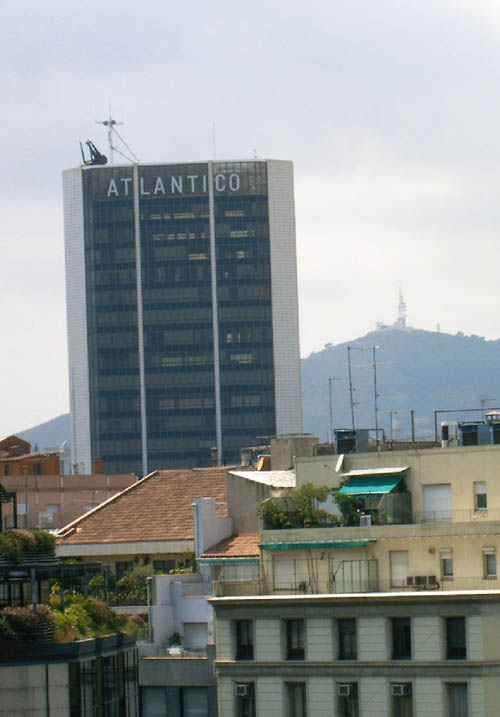L´Eixample
-La Pedrera,
Gaudí and other modernista buildings
The 3rd day on
the trip(Aug. 6 -04), we visited Antoni Gaudí and the other modernista architect´s
extraordinary buildings. The most famous ones are La
Sagrada Familia and La Pedrera (Casa Milà). Most of them are situated
in the district of L'Eixample.
Antoni Gaudí (1852-1926) was the most
famous person of the modernista (el modernisme), a style were the buildings were
decorated with shattered tile in colourful mosaic patterns. This techinique was
used at the roof of La Pedrera and Parc Güell. Curvy, imaginative shapes make
the building look a bit like fairy tale castles. Gaudí and the other modernista
architect's buildings can be see all over Barcelona, but most of them are situated
in Eixample, a very large district situated just north of Gran Via. Even if our
hostal was located in the west part of Eixample, the modernista style is not so
obvious until you come to Placa Catalunya and go north on Passeig de Gracia. Modernista
buildings are situated on both sides of this avenue. After walking just one block
from Placa Catalunya in the hot sun, we could see the first modernista buildings,
Casa Bassegoda and Casa Mestres(pics destroyed, unknown reason). On the way, we
looked a bit at La Rambla Catalunya, the northern and much calmer extension of
La Rambla, as it goes parallel to Passeig de Gracia. Eixample means "expansion"
and is called so because this was the area where the creativity flew when the
boundaries of Barcelona was expanded. As the classic style was mostly concentrated
to Madrid, the modernist and the gothic style thrived in Barcelona.
Casa Milà, also called La Pedrera (the quarry), is Antoni Gaudí's most famous
residence building and one of the main symbols of Barcelona. Completed in1910,
it has 7 floors, of wich 5 floors are open to public. On this photo you can see
why the balconies are famous.
For €6 and a long wait in the line, we visited the building.
The largest of Casa Milà's 2 courtyard and the lobby of the buildings. It
has a marble floor, decorations on the walls and a special stairway.
El Pis de La Pedrera is the furnished 4th floor. It is recreated as an apartment
of a Barcelona bourgeois family during the first decades of the 20th century.
As you can see, it is much more conservative than the façade. Casa Milà was the
last thing Gaudi did before going all over to construct Sagrada Familia. Today
the building is owned by the bank Caixa de Catalunya and it has modern elevators.
Espai Gaudí with its
brick vaults is the museum on the attic about Gaudi's life.
The roof with its odd, but beautiful sculptures is almost the main attraction
of the building. There is also a nightclub called La Pedrera de Nit. We visited
two floors of exhibitions about Indians and stuff, but the architecture of the
building is much more interesting than any museum or exhibition.
Views
from the sunny roof of La Pedrera:
The surrealistic sculptures of ancient armours are actually chimneys. Torre
Agbar to the right.
Sagrada Familia, another Gaudí building.
Torre Agbar and Diagonal Mar skyline above shabby roofs.
Northwest, towards the mountains.

Banco Atlantico. Built in 1969 as the first skyscraper on Avinguda Diagonal. 23
floors, 80m.
This view follow Passeig de Gracia to the north. The place with the obelisque,
were it crosses Avinguda Diagonal, is
Placa Joan Carles and the glass highrise
is the 19-story Deutsche Bank.
A nice view over Passeig de Gracia. In the middle you can see Mansana de la
Discordia.
Casa
Terrades, or Casa de les Punxes as it also is called, was created by the modernista
architect Puig I Cadafalch 1903-05.
With its spires it is inspired by the gothic
style.
Placa
de Mossen Jacint Verdaguel at Avinguda Diagonal. Casa Macaya is situated here.
Don't know if it is on the photo though.

Casa Batlló and Casa Amatller,
Casa Lleó Morera. This quarter is called Mansana de la Discòrdia. It got it's
name from the dramatic contrast between the dominating buildings. The competing
modernista architects Gaudí, Domènech i Montaner and Puig made these houses for
competing families. They were built between 1900 and 1907. Casa Batlló is one of Gaudí's most famous works. (The photo above is hotlinked
from another websit, as our photos got destroyed by some strange reason.)
After a little more walk, we reached Sagrada Familia. It was an incredible sight! But this amazing Gaudí cathedral is represented on a separate page.
Casa
Milà at dark.
These photos were taken another day.
Hotel Majestic at dark. Majestic is a 5-star luxury hotel, one of Barcelona´s
best.
I
stayed at a hostal (B&B) with my girlfriend for 4 nights and 5 days. It was almost
idealistically located between midway between the main hubs Placa d´Espana and
Placa Catalunya, in the crossing of Gran Via and Comte d´Urgell, 2 of the city's
longest streets.
This is the
view from the hostal at daytime, taken our first morning in Barcelona towards
Comte d´Urgell. The first one is towards the north, the Tibidabo mountain, Torre
de Collserola and the temple. The 2nd one is to the south and the crossing of
Gran Via.